Language/Tosk-albanian/Grammar/Gender
Hi Tosk Albanian learners! 😊
In this lesson, we will learn about the gender rules in Tosk Albanian. We will look at the rules for nouns, adjectives and pronouns. We will also look at some examples and practice the rules. At the end of the lesson, there will be a quiz to test your understanding. Let's get started!
Rules
In Tosk Albanian, nouns, adjectives and pronouns have gender. There are two genders: masculine and feminine.
Nouns
Most nouns in Tosk Albanian have a gender. The gender of a noun is usually indicated by the ending of the word. For example, the word femër (woman) is feminine, while the word burrë (man) is masculine.
Adjectives
Adjectives must agree with the noun they modify in gender. For example, the adjective i madh (big) changes to e madhe when it modifies a feminine noun.
Pronouns
Pronouns also have gender. The personal pronouns unë (I), ti (you), ai (he) and ajo (she) indicate the gender of the person being referred to.
Examples
Here are some examples of nouns, adjectives and pronouns in Tosk Albanian:
| Tosk Albanian | Pronunciation | English Translation |
|---|---|---|
| femër | fe-mehr | woman |
| burrë | bu-reh | man |
| i madh | ee ma-dh | big (masculine) |
| e madhe | eh ma-dheh | big (feminine) |
| unë | u-neh | I (masculine) |
| ajo | ah-yo | she (feminine) |
Practice
To improve your Tosk Albanian Grammar, you can also use the Polyglot Club website. Find native speakers and ask them any questions!
Quiz
Test your understanding of the gender rules in Tosk Albanian with this quiz.
Questions
1. What are the two genders in Tosk Albanian? 2. How do you know the gender of a noun? 3. How do adjectives agree with the noun they modify? 4. What are the personal pronouns for "I" and "she"?
Answers
1. Masculine and feminine. 2. The gender of a noun is usually indicated by the ending of the word. 3. Adjectives must agree with the noun they modify in gender. 4. Unë (I, masculine) and ajo (she, feminine).
➡ If you have any questions, please ask them in the comments section below.
➡ Feel free to edit this wiki page if you think it can be improved. 😎
Related Lessons

